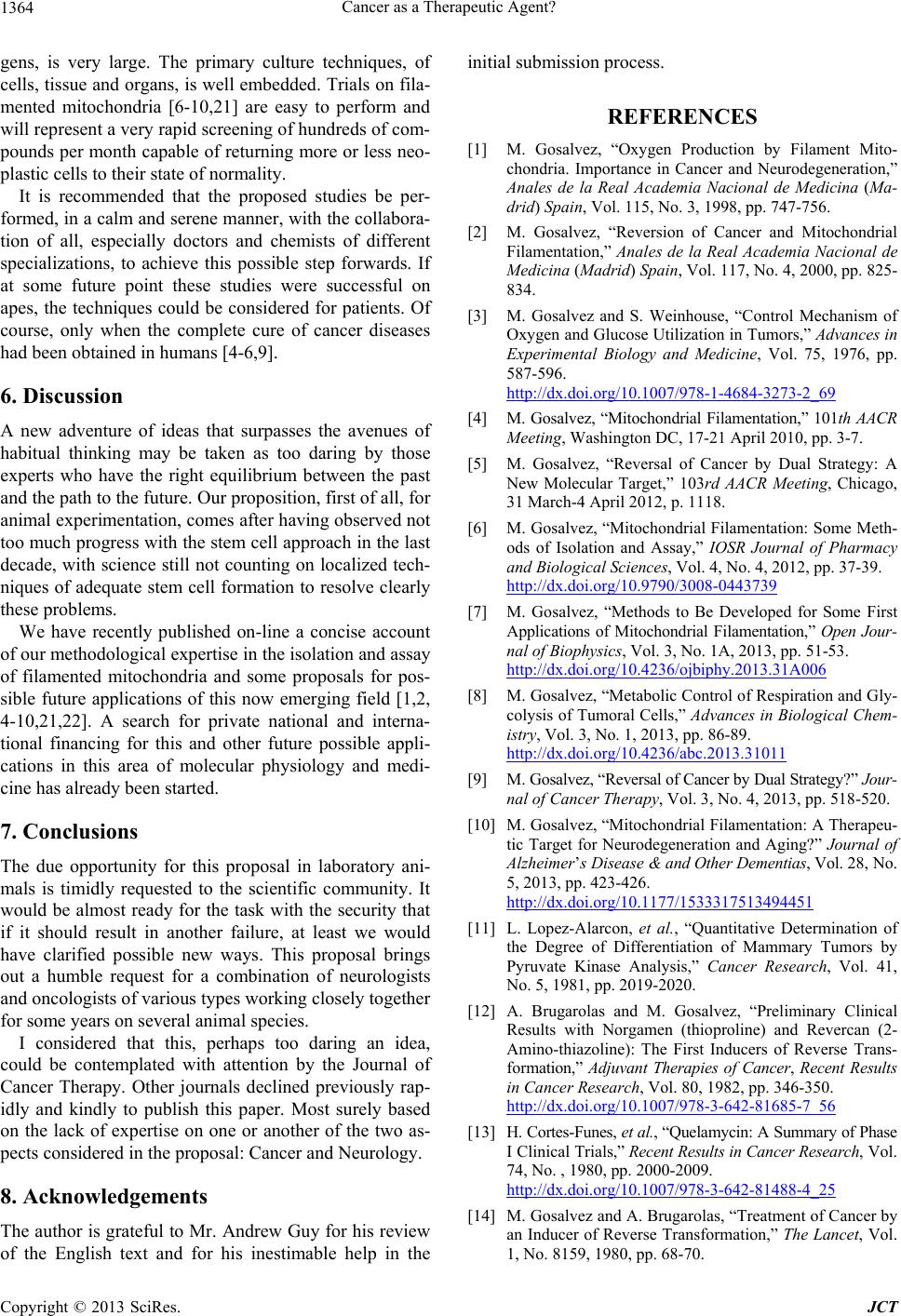
Cancer as a Therapeutic Agent ?
1364
gens, is very large. The primary culture techniques, of
cells, tissue and organs, is well embedded. Trials on fila-
mented mitochondria [6-10,21] are easy to perform and
will represent a very rapid screen ing of hundred s of co m-
pounds per month capable of returning more or less neo-
plastic cells to their state of normality.
It is recommended that the proposed studies be per-
formed, in a calm and serene manner, with the collabora-
tion of all, especially doctors and chemists of different
specializations, to achieve this possible step forwards. If
at some future point these studies were successful on
apes, the techniques could be considered for patients. Of
course, only when the complete cure of cancer diseases
had been obtained in humans [4-6,9].
6. Discussion
A new adventure of ideas that surpasses the avenues of
habitual thinking may be taken as too daring by those
experts who have the right equilibrium between the past
and the path to the fu ture. Our prop ositio n, first of all, fo r
animal experimentation, comes after having observed not
too much progress with the stem cell approach in the last
decade, with science still not counting on localized tech-
niques of adequate stem cell formation to resolve clearly
these problems.
We have recently published on-line a concise account
of our methodological expertise in the isolation and assay
of filamented mitochondria and some proposals for pos-
sible future applications of this now emerging field [1,2,
4-10,21,22]. A search for private national and interna-
tional financing for this and other future possible appli-
cations in this area of molecular physiology and medi-
cine has already been started.
7. Conclusions
The due opportunity for this proposal in laboratory ani-
mals is timidly requested to the scientific community. It
would be almost ready for the task with the security that
if it should result in another failure, at least we would
have clarified possible new ways. This proposal brings
out a humble request for a combination of neurologists
and oncologists of various types working closely together
for some years on several animal species.
I considered that this, perhaps too daring an idea,
could be contemplated with attention by the Journal of
Cancer Therapy. Other journals declined previously rap-
idly and kindly to publish this paper. Most surely based
on the lack of expertise on one or another of the two as-
pects considered in the proposal: Cancer and Neurolog y.
8. Acknowledgements
The author is grateful to Mr. Andrew Guy for his review
of the English text and for his inestimable help in the
initial submission process.
REFERENCES
[1] M. Gosalvez, “Oxygen Production by Filament Mito-
chondria. Importance in Cancer and Neurodegeneration,”
Anales de la Real Academia Nacional de Medicina (Ma-
drid) Spain, Vol. 115, No. 3, 1998, pp. 747-756.
[2] M. Gosalvez, “Reversion of Cancer and Mitochondrial
Filamentation,” Anales de la Real Academia Nacional de
Medicina (Madrid) Spain, Vol. 117, No. 4, 2000, pp. 825-
834.
[3] M. Gosalvez and S. Weinhouse, “Control Mechanism of
Oxygen and Glucose Utilization in Tumors,” Advances in
Experimental Biology and Medicine, Vol. 75, 1976, pp.
587-596.
http://dx.doi.org/10.1007/978-1-4684-3273-2_69
[4] M. Gosalvez, “Mitochondrial Filamentation,” 101th AACR
Meeting, Washington DC, 17-21 April 2010, pp. 3-7.
[5] M. Gosalvez, “Reversal of Cancer by Dual Strategy: A
New Molecular Target,” 103rd AACR Meeting, Chicago,
31 March-4 April 2012, p. 1118.
[6] M. Gosalvez, “Mitochondrial Filamentation: Some Meth-
ods of Isolation and Assay,” IOSR Journal of Pharmacy
and Biological Sciences, Vol. 4, No. 4, 2012, pp. 37-39.
http://dx.doi.org/10.9790/3008-0443739
[7] M. Gosalvez, “Methods to Be Developed for Some First
Applications of Mitochondrial Filamentation,” Open Jour-
nal of Biophysics, Vol. 3, No. 1A, 2013, pp. 51-53.
http://dx.doi.org/10.4236/ojbiphy.2013.31A006
[8] M. Gosalvez, “Metabolic Control of Respiration and Gly-
colysis of Tumoral Cells,” Advances in Biological Chem-
istry, Vol. 3, No. 1, 2013, pp. 86-89.
http://dx.doi.org/10.4236/abc.2013.31011
[9] M. Gosalvez, “Reversal of Cancer by Dual Strategy?” Jour-
nal of Cancer Therapy, Vol. 3, No. 4, 2013, pp. 518-520.
[10] M. Gosalvez, “Mitochondrial Filamentation: A Therapeu-
tic Target for Neurodegeneration and Aging?” Journal of
Alzheimer’s Di seas e & and Other Dementias, Vol. 28, No.
5, 2013, pp. 423-426.
http://dx.doi.org/10.1177/1533317513494451
[11] L. Lopez-Alarcon, et al., “Quantitative Determination of
the Degree of Differentiation of Mammary Tumors by
Pyruvate Kinase Analysis,” Cancer Research, Vol. 41,
No. 5, 1981, pp. 2019-2020.
[12] A. Brugarolas and M. Gosalvez, “Preliminary Clinical
Results with Norgamen (thioproline) and Revercan (2-
Amino-thiazoline): The First Inducers of Reverse Trans-
formation,” Adjuvant Therapies of Cancer, Recent Results
in Cancer Research, Vol. 80, 1982, pp. 346-350.
http://dx.doi.org/10.1007/978-3-642-81685-7_56
[13] H. Cortes- Funes, et al., “Que lamycin: A Summary of Phase
I Clinical Trials,” Recent Results in Cancer Research, Vol.
74, No. , 1980, pp. 2000-2009.
http://dx.doi.org/10.1007/978-3-642-81488-4_25
[14] M. Gosalvez and A. Brugarolas, “Treatment of Cancer by
an Inducer of Reverse Transformation,” The Lancet, Vol.
1, No. 8159, 1980, pp. 68-70.
Copyright © 2013 SciRes. JCT